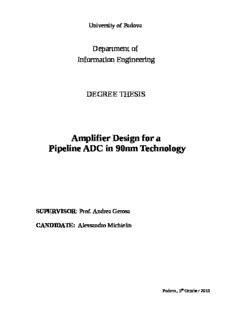
Amplifier Design for a Pipeline ADC in 90nm Technology PDF
Preview Amplifier Design for a Pipeline ADC in 90nm Technology
University of Padova Department of Information Engineering DEGREE THESIS Amplifier Design for a Pipeline ADC in 90nm Technology SUPERVISOR: Prof. Andrea Gerosa CANDIDATE: Alessandro Michielin Padova, 5th October 2010 I would like to thank my family for the constant support, prof. Gerosa for the guidance throughout the whole Master Degree, and the nSilition staff; in particular Thierry and Laurent for their continuous technical and logistic support on my internship period. Summary Abstract 5 Chapter 1 7 1.0 Introduction 7 1.2 Thesis organization 8 Chapter 2 11 2.0 Ideal A/D Converter 11 2.1 Pipeline ADC 12 2.3 MDAC operation 13 2.4 Pipelined ADC Performance Characteristics 15 2.5 Double sampling tecnique 16 2.6 Derivation of the OperationalAmplifier Parameters 17 2.6.1 Open loop DC-Gain 18 2.6.2 Gain Bandwidth 19 2.6.3 Slew Rate 21 2.6.4 Noise considerations 22 Chapter 3 25 3.0 Introduction 25 3.1 Current losses 26 3.1.1. Tunnelling 26 3.1.2. GIDL 28 3.1.3 DIBL 29 3.2 Punchtrough 29 3.3 Surface scattering 30 3.4 Velocity saturation 31 3.5 Impact ionization 31 3.6 Hot electrons 32 3.7 The modification of the threshold voltage due to SC Effects 32 - 1 - 3.8 Output conductance reduction 35 3.8.1 Lightly doped drain implant 36 3.8.2 Halo Implant 36 3.8.3 Anti Punchthrough Implant 38 Chapter 4 41 4.0 Introduction 41 4.1.1 Fifth stage amplifier: differential 41 4.1.2 Folded cascode architecture 43 4.1.3 Cascode structure 44 4.1.4 Double input pair 46 4.1.5 Biasing strategy 51 4.1.6 Power down switches 54 4.1.7 Noise 57 4.2.0 Stage 3 amplifier 58 4.2.1 Telescopic cascode 59 4.2.2 Output stage 60 4.2.3 Two stages amplifier compensation 61 Chapter 5 67 5.0 Introduction 67 5.1 Stage 5 common mode regulator topologies 67 5.1.1 Inverter based comparator 68 5.1.2 Current based comparison 68 5.1.3 Voltage buffers comparison 69 5.2 Stage 5 common mode rejection 71 5.3 Stage 3 commmon mode feedback regulator 73 Chapter 6 79 6.0 Introduction 79 6.1 Reusability 79 6.2.1 Stage 5 op-amp AC behaviour 81 6.2.2 Stage 5 CM behaviour 84 6.2.3 Max dynamic configuration 88 - 2 - 6.2.4 Noise 90 6.2.5 Montecarlo 91 6.2.6 Start-up and switch down 93 6.2.6 INL simulation 95 6.3.0 Stage 3 characterization 97 6.3.1 AC behaviour 97 6.3.2 CM behaviour 97 6.3.3 Max dynamic configuration 101 6.3.4 Noise 102 6.3.5 Montecarlo 102 Chapter 7 105 7.0 Introduction 105 7.1 Main sources of variations 106 7.2 Interdigit structure 107 7.3 Antenna effect and antenna diodes 108 7.4 Dummy transistors 110 7.5 Electromigration 112 7.6 General consideration for layouting 114 Chapter 8 117 8.0 Introduction 117 8.1 Future Work 118 Appendix A 121 Appendix B 129 Appendix C 131 - 3 - - 4 - Abstract This paper explains the choices taken for the design of two full differential operational amplifiers. These op amp have been designed for the third and the fifth stage of a pipelined A/D Converter. It shows also the solutions found to reach high gain, wide bandwidth and short settling time, without degrading too much the output swing. First the operational amplifier specification are extracted starting from the ADC architecture, then the issues related to the sub-micrometrical design are analysed; the different structures tested are then presented and the motivation of the final topology choice are shown. It presents then the op amp schematic implementation, the simulation results and the layout with the 90nm TSMC design kit. - 5 - - 6 -
Description: